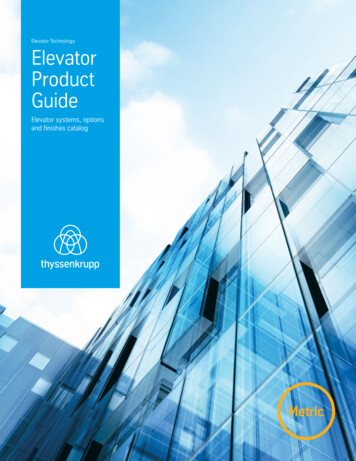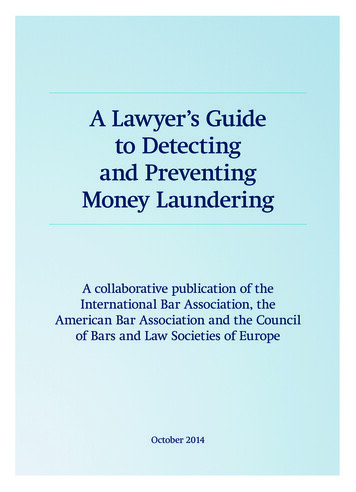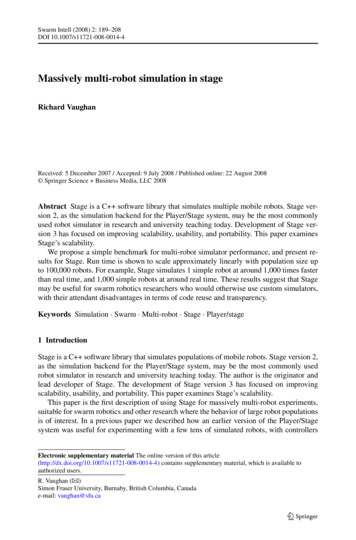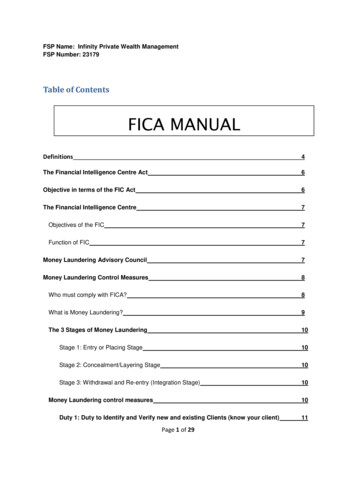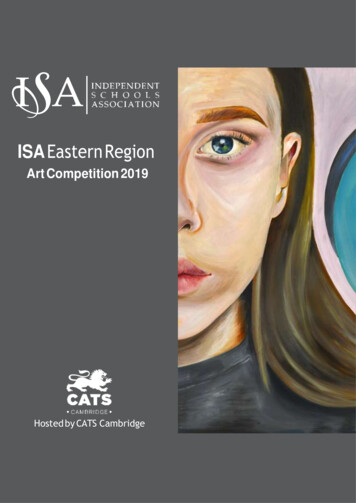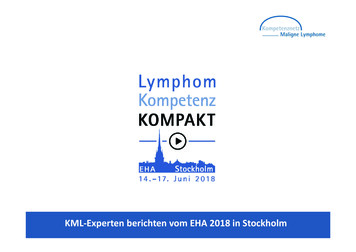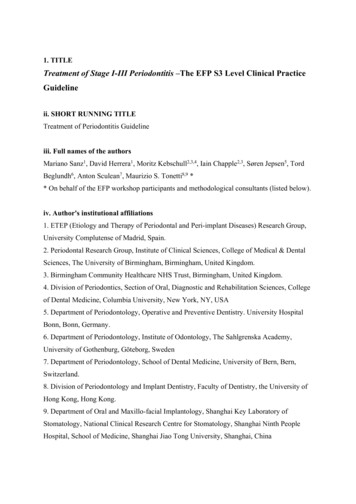
Transcription
1. TITLETreatment of Stage I-III Periodontitis –The EFP S3 Level Clinical PracticeGuidelineii. SHORT RUNNING TITLETreatment of Periodontitis Guidelineiii. Full names of the authorsMariano Sanz1, David Herrera1, Moritz Kebschull2,3,4, Iain Chapple2,3, Søren Jepsen5, TordBeglundh6, Anton Sculean7, Maurizio S. Tonetti8,9 ** On behalf of the EFP workshop participants and methodological consultants (listed below).iv. Author's institutional affiliations1. ETEP (Etiology and Therapy of Periodontal and Peri-implant Diseases) Research Group,University Complutense of Madrid, Spain.2. Periodontal Research Group, Institute of Clinical Sciences, College of Medical & DentalSciences, The University of Birmingham, Birmingham, United Kingdom.3. Birmingham Community Healthcare NHS Trust, Birmingham, United Kingdom.4. Division of Periodontics, Section of Oral, Diagnostic and Rehabilitation Sciences, Collegeof Dental Medicine, Columbia University, New York, NY, USA5. Department of Periodontology, Operative and Preventive Dentistry. University HospitalBonn, Bonn, Germany.6. Department of Periodontology, Institute of Odontology, The Sahlgrenska Academy,University of Gothenburg, Göteborg, Sweden7. Department of Periodontology, School of Dental Medicine, University of Bern, Bern,Switzerland.8. Division of Periodontology and Implant Dentistry, Faculty of Dentistry, the University ofHong Kong, Hong Kong.9. Department of Oral and Maxillo-facial Implantology, Shanghai Key Laboratory ofStomatology, National Clinical Research Centre for Stomatology, Shanghai Ninth PeopleHospital, School of Medicine, Shanghai Jiao Tong University, Shanghai, China
Workshop ParticipantsAnne Merete Aass, Mario Aimetti, Bahar Eren Kuru, Georgios Belibasakis, Juan Blanco,Ellen Bol-van den Hil, Nagihan Bostanci, Darko Bozic, Philippe Bouchard, NurcanBuduneli, Francesco Cairo, Elena Calciolari, Maria Clotilde Carra, Pierpaolo Cortellini, JanCosyn, Francesco D’Aiuto, Bettina Dannewitz, Monique Danser, Korkud Demirel, JanDerks, Massimo de Sanctis, Thomas Dietrich, Christof Dörfer, Henrik Dommisch, NikosDonos, Kenneth Eaton, Peter Eickholz, Elena Figuero, William Giannobile, MosheGoldstein, Filippo Graziani, Phophi Kamposiora, Lise-Lotte Kirkevang, Thomas Kocher,Eija Kononen, France Lambert, Luca Landi, Nicklaus Lang, Paulo Melo, Bruno Loos,Rodrigo Lopez, Pernilla Lundberg, Eli Machtei, Phoebus Madianos, Conchita Martín, PaulaMatesanz, Jörg Meyle, Ana Molina, Eduardo Montero, Jose Nart, Ian Needleman, LuigiNibali, Panos Papapanou, Andrea Pilloni, David Polak, Ioannis Polyzois, Philip Preshaw,Marc Quirynen, Christoph Ramseier, Stefan Renvert, Giovanni Salvi, Ignacio Sanz-Sánchez,Lior Shapira, Dagmar Else Slot, Andreas Stavropoulos, Xavier Struillou, Jean Suvan, WimTeughels, Daniela Timus, Cristiano Tomasi, Leonardo Trombelli, Fridus van der Weijden,Paula Vassallo, Clemens Walter, Nicola West, Gernot WimmerMethodological ConsultantsIna Kopp (chief consultant), Paul Brocklehurst, Jan WennströmWorkshop OrganizationEuropean Federation of PeriodontologyScientific societies involved in the guideline development processEuropean Federation of Conservative DentistryEuropean Association of Dental Public HealthEuropean Society for EndodontologyEuropean Prosthodontic AssociationOther organisations involved in the guideline development processCouncil of European DentistsEuropean Dental Hygienists’ FederationEuropean Dental Students’ AssociationPlatform for Better Oral Health in Europe2
v. AcknowledgmentsThe authors express their gratitude to all reviewers involved in the preparation of thesystematic reviews. In addition, the organizations which accepted to participate in theguideline development process are also kindly and sincerely acknowledged: EuropeanFederation of Conservative Dentistry, European Association of Dental Public Health,European Society for Endodontology, European Prosthodontic Association, Council ofEuropean Dentists, European Dental Hygienists’ Federation, European Dental Students’Association, Platform for Better Oral Health in Europe.Conflict of Interest StatementIndividual potential conflict of interest forms were completed by all participants and areavailable on file at the European Federation of Periodontology and extracted in theSupporting Information, available on line (Final Guideline-Supporting Information Potentialconflict of interests). In addition, potential conflict of interest information of the chairs of theworkshop is listed here.Dr. Sanz, Mariano (Chair) reports personal fees from Camlog implants, Colgate, Dentium Implants, DentsplySirona Implants, Geistlich, GSK, Klockner Implants, MIS Implants, Mozo Grau Implants, Nobel Biocare,Procter & Gamble, Straumann, Sunstar; grants from Camlog Implants, Dentaid, Dentium Implants, DentsplySirona Implants, Geistlich Pharma, Klockner Implants, MIS Implants, Mozo Grau Implants, Nobel Biocare,Sunstar, Straumann AG, Sweden and Martina Implants; and other support from Dentaid, outside the submittedwork.Dr. Herrera, David (Chair) reports personal fees from Colgate, Dentaid, Dexcel Pharma, GSK, Johnson &Johnson, Klockner Implants, Procter & Gamble, Straumann; grants from Colgate, Dentaid, GSK, Kulzer,Zimmer-Biomet, outside the submitted work.Dr. Kebschull, Moritz (Chair) reports personal fees from Colgate, Dexcel Pharma, Geistlich Pharma, HuFriedy, NSK, Procter & Gamble; non-financial support from Colgate, Dexcel Pharma, Geistlich Pharma, HuFriedy, NSK, Procter & Gamble, outside the submitted work.Dr. Chapple, Iain (Chair) reports personal fees from Procter & Gamble; grants from GSK, Unilever, outsidethe submitted work. In addition, Dr. Chapple has 8 patents on saliva diagnostics issued and his wife runs OralHealth Innovations that has the license for PreViser and DEPPA risk assessment software in the UK.Dr. Jepsen, Sören (Chair) reports personal fees from Colgate, Geistlich Pharma, Procter & Gamble, outside thesubmitted work.Dr. Berglundh, Tord (Chair) reports personal fees from Dentsply Sirona Implants, Straumann; grants fromDentsply Sirona Implants, outside the submitted work.Dr. Sculean, Anton (Chair) reports personal fees from Botiss Biomaterials, Geistlich Pharma, OralReconstruction Foundation, Osteology Foundation, Straumann AG, Regedent AG, Stoma; grants from BotissBiomaterials, Geistlich Pharma, ITI Foundation, Oral Reconstruction Foundation, Osteology Foundation,Straumann AG, Regedent AG; outside the submitted work.3
Dr. Tonetti, Maurizio (Chair) reports personal fees from Geistlich Pharma AG, Procter & Gamble, StraumannAG, Sunstar SA, Unilever; grants from Geistlich Pharma, Sunstar SA; non-financial support from Procter &Gamble, outside the submitted work.Corresponding authorMariano SanzETEP (Etiology and Therapy of Periodontal and Peri-implant Diseases) Research GroupFaculty of Odontology, University Complutense of MadridPlaza Ramón y Cajal s/n (Ciudad Universitaria)28040 Madrid, Spainmarsan@ucm.es 34 91 39420104
vi. Abstract and keywords;AbstractBackground: The recently introduced 2017 World Workshop classification of periodontitis,incorporating stages and grades of disease, aims to link disease classification with approachesto prevention and treatment, as it describes not only disease severity and extent, but also thedegree of complexity and an individual s risk. There is, therefore, a need for evidence-basedclinical guidelines providing recommendations to treat periodontitis.Aim: The objective of the current project was to develop a S3 Level Clinical PracticeGuideline (CPG) for the treatment of stage I-III periodontitis.Material and Methods: This S3 CPG was developed under the auspices of the EuropeanFederation of Periodontology (EFP), following the methodological guidance of theAssociation of Scientific Medical Societies in Germany and the Grading ofRecommendations Assessment, Development and Evaluation (GRADE). The rigorous andtransparent process included synthesis of relevant research in 15 specifically commissionedsystematic reviews, evaluation of the quality and strength of evidence, the formulation ofspecific recommendations and consensus, on those recommendations, by leading experts anda broad base of stakeholders.Results: The S3 CPG approaches the treatment of periodontitis (stages I, II and III) using apre-established stepwise approach to therapy that, depending on the disease stage, should beincremental, each including different interventions. Consensus was achieved onrecommendations covering different interventions, aimed at: i) behavioural changes,supragingival biofilm, gingival inflammation and risk factor control; ii) supra- and subgingival instrumentation, with and without adjunctive therapies; iii) different types ofperiodontal surgical interventions; and iv) the necessary supportive periodontal care to extendbenefits over time.Conclusion: This S3 guideline informs clinical practice, health systems, policymakers and,indirectly, the public, on the available and most effective modalities to treat periodontitis andto maintain a healthy dentition for a lifetime, according to the available evidence at the timeof publication.Key words: periodontitis, stage, grade, clinical guideline, periodontal therapy, health policy,oral health5
vii. Clinical RelevanceScientific rationale for the studyImplementation of the new classification of periodontitis should be facilitate the use of themost appropriate preventive and therapeutic interventions, depending on the stage and gradeof the disease. The choice of these interventions should be made following a rigorousevidence-based decision-making process.Principal findingsThis guideline has been developed using strict validated methodologies for assuring the bestavailable evidence on the efficacy of the interventions considered and the most appropriaterecommendations based on a structured consensus process, including a panel of experts andrepresentatives from key stakeholders.Practical implicationsThe application of this S3 Level Clinical Practice Guideline will allow a homogeneous andevidence-based approach to the management of stages I-III periodontitis.6
IntroductionThe Health ProblemDefinitionPeriodontitis is characterized by progressive destruction of the tooth‐supporting apparatus. Itsprimary features include the loss of periodontal tissue support manifest through clinicalattachment loss (CAL) and radiographically assessed alveolar bone loss, presence ofperiodontal pocketing and gingival bleeding (Papapanou et al., 2018). If untreated it may leadto tooth loss, although it is preventable and treatable in the majority of cases.ImportancePeriodontitis is a major public health problem due to its high prevalence, and since it maylead to tooth loss and disability, it negatively affects chewing function and aesthetics, is asource of social inequality, and significantly impairs quality of life. Periodontitis accounts fora substantial proportion of edentulism and masticatory dysfunction, has a negative impact ongeneral health and results in significant dental care costs (Tonetti, Jepsen, Jin, & OtomoCorgel, 2017).PathophysiologyPeriodontitis is a chronic multifactorial inflammatory disease associated with dysbiotic dentalplaque biofilms.PrevalencePeriodontitis is the most common chronic inflammatory non-communicable disease ofhumans. According to the Global Burden of Disease 2010 study, the global age-standardizedprevalence (1990-2010) of severe periodontitis was 11.2%, representing the sixth-mostprevalent condition in the world (Kassebaum et al., 2014), while in the Global Burden ofDisease 2015 study, the prevalence of severe periodontitis was estimated in 7.4%(Kassebaum et al., 2017). The prevalence of milder forms of periodontitis may be as high as50% (Billings et al., 2018).Consequences of failure to treat7
Untreated or inadequately treated periodontitis leads to the loss of tooth-supporting tissuesand teeth. Severe periodontitis, along with dental caries is responsible for more years lost todisability than any other human disease (GBD 2017 Disease and Injury Incidence andPrevalence Collaborators, 2018). Furthermore, periodontal infections are associated with arange of systemic diseases leading to premature death, including diabetes (Sanz et al., 2018),cardiovascular diseases (Sanz et al., 2019; Tonetti, Van Dyke, & Working group 1 of thejoint EFP/AAP Workshop, 2013) or adverse pregnancy outcomes (Sanz, Kornman, &Working group 3 of joint EFP/AAP Workshop, 2013).Economic importanceOn a global scale, periodontitis is estimated to cost 54 billion in direct treatment costs andfurther 25 billion in indirect costs (GBD 2017 Disease and Injury Incidence and PrevalenceCollaborators, 2018). Periodontitis contributes significantly to the cost of dental diseases dueto the need to replace teeth lost to periodontitis. The total cost of dental diseases, in 2015,was estimated to be of 544.41 billion, being 356.80 billion direct costs, and 187.61 billionindirect costs (Righolt, Jevdjevic, Marcenes, & Listl, 2018).8
Aim of the GuidelineThis guideline aims to highlight the importance and need for scientific evidence in clinicaldecision making in the treatment of patients with periodontitis stages I to III. Its mainobjective is therefore, to support the evidence-based recommendations for the differentinterventions used at the different steps of periodontal therapy, based on the best availableevidence and/or expert consensus. In so doing, this guideline aims to improve the overallquality of periodontal treatment in Europe, reduce tooth loss associated with periodontitis andultimately improve overall systemic health and quality of life. A separate guideline coveringthe treatment of stage IV periodontitis will be published.Target users of the guidelineDental and medical professionals, together with all stakeholders related to health care,particularly oral health, including patients.Targeted environmentsDental and medical academic / hospital environments, clinics and practices.Targeted patient populationPeople with periodontitis stages I to III.People with periodontitis stages I to III following successful treatment.Exceptions from the guidelineThis guideline did not consider the health economic cost-benefit ratio, since (i) it coversmultiple different countries with disparate, not readily comparable health systems, and (ii)there is a paucity of sound scientific evidence available addressing this question. Thisguideline did not consider the treatment of gingivitis (although management of gingivitis isconsidered as an indirect goal in some interventions evaluated), the treatment of stage IVperiodontitis, necrotising periodontitis, periodontitis as manifestation of systemic diseasesand mucogingival conditions.9
MethodologyGeneral frameworkThis guideline was developed following methodological guidance published by the StandingGuideline Commission of the Association of Scientific Medical Societies in Germany(AWMF) mf-guidance.html) and theGrading of Recommendations Assessment, Development and Evaluation (GRADE) WorkingGroup (https://www.gradeworkinggroup.org/).The guideline was developed under the auspices of the European Federation ofPeriodontology (EFP) and overseen by the EFP Workshop Committee. This guidelinedevelopment process was steered by an Organizing Committee and a group of methodologyconsultants designated by the EFP. All members of the Organizing Committee were part ofthe EFP Workshop Committee.To ensure adequate stakeholder involvement, the EFP established a guideline panel involvingdental professionals representing 36 national periodontal societies within the EFP (Table 1a).These delegates were nominated, participated in the guideline development process and hadvoting rights in the consensus conference. For the guideline development process, delegateswere assigned to four Working Groups that were chaired by the members of the OrganizingCommittee and advised by the methodology consultants. This panel was supported by keystakeholders from European scientific societies with a strong professional interest inperiodontal care and from European organizations representing key groups within the dentalprofession, and key experts from non-EFP member countries, such as North America (Table1b).In addition, EFP engaged an independent guideline methodologist to advise the panel andfacilitate the consensus process (Prof. Dr. med. Ina Kopp). The guideline methodologist hadno voting rights.EFP and the guideline panel tried to involve patient organizations but were not able toidentify any regarding periodontal diseases at European Level. In a future update, efforts willbe undertaken to include the perspective of citizens/patients (Brocklehurst et al., 2018).10
Evidence SynthesisSystematic search and critical appraisal of guidelinesTo assess and utilize existing guidelines during the development of the present guideline,well-established guideline registers and the websites of large periodontal societies wereelectronically searched for potentially applicable guideline texts: Guideline International Network (GIN) Guidelinecentral.com The National Institute for Health and Clinical Excellence (NICE) Canadian Health Technology Assessment (CADTH) European Federation for Periodontology (EFP) American Academy of Periodontology (AAP) American Dental Association (ADA)The last search was performed on 30.09.2019. Search terms used were: “periodont*”Periodontal”, “Guidelines, “Clinical Practice Guidelines”. In addition, content was screenedby hand searches. See Table 2.Only guidelines published in English and with full texts available were included. Themethodological quality of these guideline texts was critically appraised using the AGREE IIframework (https://www.agreetrust.org/agree-ii/).Most of the identified guidelines/documents were considered not applicable due to (i) theirage, (ii) their methodological approach, or (iii) their inclusion criteria. The recent GermanS3-guideline (Register Number 083-029) was found to be potentially relevant, scored highestin the critical appraisal using AGREE II and was, therefore, used to inform the guidelinedevelopment process.Systematic search and critical appraisal of the literatureFor this guideline, a total of 15 systematic reviews (SRs) were conducted to support theguideline development process (Carra et al., 2020; Dommisch, Walter, Dannewitz, &Eickholz, 2020; Donos et al., 2019; Figuero, Roldan, et al., 2019; Herrera et al., 2020; Jepsenet al., 2019; Nibali et al., 2019; Polak et al., 2020; Ramseier et al., 2020; Salvi et al., 2019;11
Sanz-Sanchez et al., 2020; Slot, Valkenburg, & van der Weijden, 2020; Suvan et al., 2019;Teughels et al., 2020; Trombelli et al., 2020). The corresponding manuscripts are publishedwithin this special issue of the Journal of Clinical Periodontology.All SRs were conducted following the “Preferred Reporting Items for Systematic Reviewsand Meta-Analyses” (PRISMA) framework (Moher, Liberati, Tetzlaff, & Altman, 2009).Focused questionsIn all 15 systematic reviews, focused questions in PICO(S) format (Guyatt et al., 2011) wereproposed by the authors in January 2019 to a panel comprising the working group chairs andthe methodological consultants, in order to review and approve them (Table 3). The paneltook great care to avoid overlaps or significant gaps between the SRs, so they would trulycover all possible interventions currently undertaken in periodontal therapy.Relevance of outcomesA narrative review paper was commissioned for this guideline (Loos & Needleman, 2020) toevaluate the possible outcome measures utilized to evaluate the efficacy of periodontaltherapy in relation to true patient-centred outcomes like tooth retention/loss. The authorsfound that the commonly reported outcome variable with the best demonstrated predictivepotential for tooth loss was the reduction in periodontal probing pocket depth (PPD).Therefore, for this guideline, PPD reduction was used as primary outcome for thosesystematic reviews not addressing periodontal regeneration, and where tooth survival datawere not reported. When reviewing regenerative interventions, gains in clinical attachmentwere used as the primary outcome measure. To avoid introducing bias by including possiblyspurious findings of studies with very short follow-up, a minimal follow-up period of sixmonths was requested for all reviews.Search strategyAll SRs utilized a comprehensive search strategy of at least two different databases,supplemented by a hand search of periodontal journals and the reference lists of includedstudies.In all SRs, the electronic and manual search, as well as the data extraction, was done inparallel by two different investigators.12
Quality assessment of included studiesIn all SRs, the risk of bias of controlled clinical trials was assessed using the Cochrane Riskof bias tool . For observational studies, the Newcastle-Ottawa-Scale was usedhttp://www.ohri.ca/programs/clinical epidemiology/oxford.asp.Data synthesisWhere applicable, the available evidence was summarized by means of meta-analysis, orother tools aimed for pooling data (network meta-analysis, Bayesian network meta-analysis).From Evidence to Recommendation: Structured Consensus ProcessThe structured consensus development conference was held during the XVI EuropeanWorkshop in Periodontology in La Granja de San Ildefonso Segovia, Spain, on November10th – 13th, 2019. Using the 15 SRs as background information, evidence-basedrecommendations were formally debated by the guideline panel using the format of astructured consensus development conference, consisting of small group discussions andopen plenary were the proposed recommendations were presented, voted and adopted byconsensus and (Murphy et al., 1998).In the small group phase, delegates convened in four working groups addressing thefollowing subtopics; 1) “periodontitis stages I & II”; 2) “periodontitis stage III”; 3)“periodontitis stage III with intraosseous defects and/or furcations”, and 4) “supportiveperiodontal care”. This working groups were directed by two chairpersons belonging to theEFP Workshop Committee. With the support of an expert in methodology in each workinggroup, recommendations and draft background texts were generated and subsequentlypresented, debated and put to a vote in the plenary of all delegates. During these plenarysessions. the guideline development process and discussions and votes were overseen andfacilitated by the independent guideline methodologist (I.K.). The plenary votes wererecorded using an electronic voting system, checked for plausibility in then introduced intothe guideline text.The consensus process was conducted as follows:Plenary 113
Introduction to guideline methodology (presentation, discussion) by the independentguideline methodologist (I.K.).Working group Phase 1-Peer evaluation of declarations of interest and management of conflicts.-Presentation of the evidence (SR results) by group chairs and methodologyconsultants.-Invitation of all members of the working group to reflect critically on the quality ofavailable evidence by group chairs, considering GRADE criteria.-Structured group discussion:o development of draft recommendation and their grading, consideringGRADE-criteria.o development of draft background texts, considering GRADE-criteria.o invitation to comment draft recommendations and background text to suggestreasonable amendments by group chairs.o collection and merging of amendments by group chairs.o initial voting within the working group on recommendations and guidelinetext to be presented as group result in the plenary.Plenary 2-Presentation of working group results (draft recommendations and background text)by Working Group chairs.-Invitation to formulate questions, statements and reasonable amendments of theplenary by the independent guideline methodologist /facilitator.-Answering of questions by working group chairpersons.-Collection and merging of amendments by independent moderator.-Preliminary vote on all suggestions provided by the working groups and allreasonable amendments.-Assessment of the strength of consensus.-Opening debate, where no consensus was reached or reasonable need for discussionwas identified.-Formulation of tasks to be solved within the working groups.Working Group Phase 214
-Discussion of tasks and potential amendments raised by the plenary.-Formulation of reasonable and justifiable amendments, considering the GRADEframework.-Initial voting within the working group on recommendations and guideline text forplenary.Plenary 3-Presentation of working group results by working group chairpersons.-Invitation to formulate questions, statements and reasonable amendments of theplenary by the independent moderator.-Collection and merging of amendments by independent moderator.-Preliminary vote.-Assessment of the strength of consensus.-Opening debate, where no consensus was reached or reasonable need for discussionwas identified.-Formulation of reasonable alternatives.-Final vote of each recommendation.Definitions: Rating the Quality of Evidence, Grading the Strength of Recommendationsand Determining the Strength of ConsensusFor all recommendations and statements, this guideline makes transparent the underlying quality of evidence, reflecting the degree of certainty / uncertainty ofthe evidence and robustness of study results the grade of the recommendation, reflecting criteria of considered judgement thestrength of consensus, indicating the degree of agreement within the guideline paneland thus, reflecting the need of implementationQuality of EvidenceThe quality of evidence was assessed using a recommended rating scheme (Balshem et al.,2011; Schunemann, Zhang, Oxman, & Expert Evidence in Guidelines, 2019).Strength of Recommendations15
The grading of the recommendations used the grading scheme (Table 4) by the (GermanAssociation of the Scientific Medical Societies (AWMF) & Standing GuidelinesCommission, 2012), taking into account not only the quality of evidence, but also consideredjudgement, guided by and the following criteria: relevance of outcomes and quality of evidence for each relevant outcome consistency of study results directness regarding applicability of the evidence to the target population/PICOspecifics precision of effect estimates regarding confidence intervals magnitude of the effects balance of benefit and harm ethical, legal, economic considerations patient preferencesThe grading of the quality of evidence and the strength of a recommendation may thereforediffer in justified cases.Strength of ConsensusThe consensus determination process followed the recommendations by the (GermanAssociation of the Scientific Medical Societies (AWMF) & Standing GuidelinesCommission, 2012). In case, consensus could not be reached, different points of view weredocumented in the guideline text. See Table 5.Editorial IndependenceFunding of the guidelineThe development of this guideline and its subsequent publication was financed entirely byinternal funds of the European Federation of Periodontology, without any support fromindustry or other organisations.Declaration of Interests and Management of Potential ConflictsAll members of the guideline panel declared secondary interests using the standardized formprovided by the International Committee of Medical Journal Editors (ICMJE) (InternationalCommittee of Medical Editors).16
Management of conflicts of interests (CoI) was discussed in the working groups, followingthe principles provided by the Guidelines International Network (Schunemann et al., 2015).According to these principles, panel members with relevant, potential CoI abstained fromvoting on guideline statements and recommendations within the consensus process.Peer reviewAll 15 systematic reviews, and the position paper on outcome variables commissioned forthis guideline, underwent a multi-step peer review process. First, the draft documents wereevaluated by members of the EFP Workshop Committee and the methodological consultantsusing a custom-made appraisal tool to assess (i) the methodological quality of the SRs usingthe AMSTAR 2 checklist (Shea et al., 2017), and (ii) whether all PICO(S) questions wereaddressed as planned. Detailed feedback was then provided for the SR authors. Subsequently,all 15 systematic reviews and the position paper underwent the regular editorial peer reviewprocess defined by the Journal of Clinical Periodontology.The guideline text was drafted by the chairs of the working groups, in close cooperation withthe methodological consultants, and circulated in the guideline group before the workshop.The methodological quality was formally assessed by an outside consultant using theAGREE framework. The guideline was subsequently peer reviewed for its publication in theJournal of Clinical Periodontology following the standard evaluation process of thisscientific journalImplementation and dissemination planFor this guideline, a multi-stage dissemination and implementation strategy will be actionedby the EFP, supported by a communication campaign.This will include:-Publication of the guideline and the underlying systematic reviews and position paperas an Open Access special issue of the Journal of Clinical Periodontology-Local uptake from national societies, either by Commentary, Adoption, or Adaptation(Schunemann et al., 2017)-Generation of educational material for dental professionals and patients,dissemination via the EFP member societies-Dissemination via educational programs on dental conferences17
-Dissemination via EFP through European stakeholders via National Societies,members of EFP-Long-term evaluation of the successful implementation of the guideline by poll ofEFP membersThe timeline of the guideline development proce
Federation of Conservative Dentistry, European Association of Dental Public Health, European Society for Endodontology, European Prosthodontic Association, Council of European Dentists, European Dental Hygienists' Federation, European Dental Students' Association, Platform for Better Oral Health in Europe. Conflict of Interest Statement

